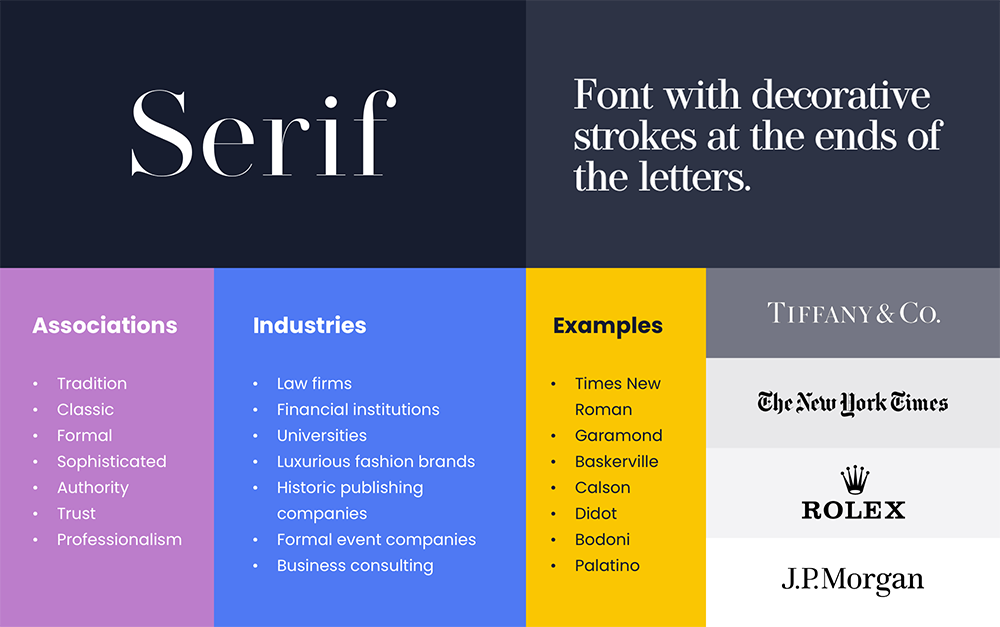Understanding the core differences between font types is essential for any brand aiming to build a recognisable identity and establish a strong, integrated digital presence. Furthermore, as fonts are a pivotal functional component of a brand’s visual identity, and have the power to evoke emotions and communicate values, their selection becomes a crucial aspect of brand strategy.
Fortunately, it’s not necessary to understand the individual differences between the thousands of fonts in existence. Rather, a general understanding of the most popular font types (from which most fonts are developed and designed) will be sufficient to guide your selection of appropriate fonts for your brand.
The literature and modern discourse reference several different font types, with differences on which are the most widely used. However, the following 4 font types have been identified as the most relevant overarching font categories: Serif, Sans-serif, Script, and Display. This article will delve into each font, exploring its unique characteristics, psychological associations, and popular industries of application.
Key Takeaways
- Serif fonts convey tradition, sophistication, and professionalism, and are ideal for brands in the law, financial, and business consulting industries.
- Sans-serif fonts are perfect for technology, creative, and lifestyle brands as these fonts symbolise modernity, clarity, and innovation.
- Script fonts offer a personalised and artistic flair, and are suited for beauty, fashion, and luxurious brands.
- Display fonts are great for brands in the entertainment and food and beverage industries, as these fonts are bold, unique, and attention-grabbing.

1. Serif fonts
Serif fonts have small decorative lines (called serifs) at the ends of the letters. These fonts have deep historical origins dating back to ancient Roman inscriptions continuing through to their predominant use in the early days of printing. This longstanding history, coupled with Serif fonts’ consistent use in formal and scholarly documents, has cemented their status as symbols of authority, credibility, and knowledge.
The decorative nature of the serifs, in contrast to the minimalist nature of Sans-serif fonts, further reinforces its connection to craftsmanship and authenticity. Additionally, Serif fonts project an aura of expertise, professionalism, and trust.
Consequently, Serif fonts have proven to be popular among brands in the law, finance, publishing, and luxury fashion industries. Thus, brands that want to convey a traditional, classic, and sophisticated identity should consider using Serif fonts in their typography.
Famous brands that use Serif fonts
Tiffany and Co.: This iconic jewelry brand's choice of a Serif font exemplifies its storied history, sophistication, and timeless appeal.
The New York Times: This renowned newspaper uses a custom version of Cheltenham for its nameplate, reinforcing its authority and tradition in journalism.
Rolex: The luxury watchmaker employs a Serif font in its logo, which adds to the brand's image of luxury, precision, and timeless elegance.
J.P. Morgan: This multinational investment bank and financial services company implements a Serif font in its branding, emphasizing its heritage and authority in the financial sector.

2. Sans-serif fonts
In contrast to Serif fonts, Sans-serif fonts are characterised by their lack of decorative lines at the ends of letters. These fonts emerged as a response to the complexities of Serif fonts, gaining prominence in the 19th and 20th centuries with the rise of modernist design movements. Their streamlined simplicity aligns with the principles of clarity and functionality, making them a symbol of modernity and progress.
Sans-serif fonts have become a cornerstone of modern typography, especially in the world of digital branding. Their minimalist, clean, and contemporary appearance means that these font types are highly versatile and effective in a wide range of channels, ranging from corporate branding to user interface design. Sans-serif fonts are therefore associated with efficiency, clarity, and innovation.
Sans-serif fonts have proven to be a popular choice among technology, lifestyle, creative, and future-focused brands. This popularity highlights the shift towards simplicity and clarity in modern-day digital design. Thus, brands aiming to project a modern, approachable, and innovative image should consider using Sans-serif fonts in their typography.
Famous brands that use Serif fonts
Google: In 2015, Google made a shift from a Serif to a custom Sans-serif font for its logo, which marked a strategic transition towards a more modern, accessible, and user-friendly brand image.
LinkedIn: LinkedIn's use of a Sans-serif font embodies clarity, simplicity, and professionalism. It underlines the professional networking platform's role as a modern, accessible tool for professionals worldwide to connect and advance their careers.
Nike: Nike's logo, the "Swoosh," is often accompanied by its wordmark in a simple, bold Sans-serif font. This choice conveys a sense of modernity, movement, and efficiency, which aligns with the brand's focus on high performance and its appeal to a wide, diverse audience.
Spotify: Spotify’s use of a Sans-serif font underlines the brand’s commitment to accessibility and ease of use, which are key aspects in the fast-paced world of digital music.

3. Script fonts
Script fonts mimic the fluidity and variability of handwriting by often featuring varied stroke weights and flowing lines. The origins of these fonts are linked to calligraphy and cursive writing styles that have been part of written human communication for centuries. Thus, the personal and artistic nature of script fonts conveys a sense of individuality and artistic flair.
The flowing and decorative nature of Script fonts stands in contrast to the more uniform and structured appearance of both Serif and Sans-serif fonts. This difference highlights Script fonts’ connection to creativity, elegance, and personal expression.
Script fonts are ideal for brands that aim to project a sense of uniqueness, artistry, or a personal touch. It has proven to be popular in the beauty, fashion, and luxury industries. However, due to their decorative nature, Script fonts require careful application as they do not offer the same level of readability as Serif and Sans-serif fonts. Script fonts are therefore best used for short texts or as accent fonts to maximize their aesthetic appeal without compromising functionality.
Famous brands that use Script fonts
Coca-Cola: Coca-Cola’s Script font, known as Spencerian script, dates back to the late 19th century and is synonymous with the brand. Its flowing, cursive style evokes feelings of nostalgia, joy, and tradition, which perfectly aligns with Coca-Cola's image as a timeless and universally beloved beverage.
Cadbury: The flowing, cursive style of Cadbury’s Script font suggests a personal touch and craftsmanship, aligning with Cadbury's long-standing history of quality confectionaries. Additionally, the font is elegant and playful which conveys the brand’s identity as a purveyor of joy and sweetness.
Ray-Ban: Ray-Ban’s Script font conveys sophistication, which mirrors the brand’s blend of a classic style with contemporary cool. The font mirrors the brand’s identity of exclusivity and elegance, underlining its status as a trendsetter in the eyewear industry.
Sharpie: Sharpie's Script font exudes creativity and spontaneity, which accentuates the brand's identity as a tool for self-expression that enables users to boldly mark their world.

4. Display fonts
Display fonts, also known as decorative or headline fonts, are designed to make a strong visual impact and attract attention. These fonts are more expressive and unique compared to Serif and Sans-serif fonts, and are more suited for an attention-grabbing headline than extended body text.
Display fonts break away from conventional typographic norms by embracing unusual shapes, exaggerated proportions, and distinctive stylistic features. This deviation from traditional font types provides more room for creativity and helps in establishing a memorable brand identity.
Display fonts are therefore effective in branding, advertising, and promotional collateral where making a strong visual statement is key. They are used in contexts where the text itself is a central design element, such as logos, posters, and digital banners.
These fonts are popular in the entertainment, fashion, and food and beverage industries, where differentiation and character are essential. However, due to Display fonts’ distinctive nature, careful consideration is required to maintain legibility and ensure that the font aligns with the brand’s identity and the target audience’s expectations.
Famous brands that use Script fonts
Lego: Lego’s bold and playful Display font reflects the brand’s focus on creativity and fun. The font's blocky, colorful, and slightly rounded style echoes the physical attributes of Lego bricks and appeals directly to the brand's primary audience of children and nostalgic adults.
Disney: Disney uses a custom, script-style Display font which is inspired by the signature of its founder, Walt Disney. The font exudes a sense of whimsy, imagination, and fantasy, which aligns with the brand’s storytelling and creative prowess.
Harley-Davidson: Harley-Davidson uses a bold and strong display font in its logo which mirrors the brand’s key characteristics of strength, freedom, and a rebellious spirit.
Metallica: The iconic heavy metal band's Display font embodies the energy, aggression, and rebellious spirit of their music. The font's sharp edges and angular, lightning-like strokes encapsulate the band's intense and dynamic sound.
Final Thought
Each font type contains characteristics and associations that can significantly shape a brand’s identity and influence the target audience’s perceptions. By strategically selecting, designing, and integrating fonts into a brand’s identity, they can effectively communicate their values, personality, and essence. Ultimately, this will increase the potential for crafting an impactful and resonant relationship with a brand’s target audience.





